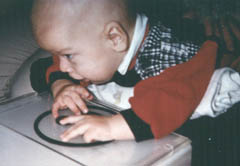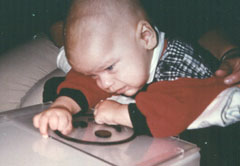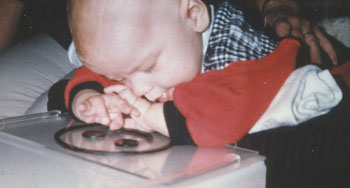4-6 months
A normally sighted infant becomes visually aware of his/her hands at the age of three months and spends hours admiring his/her fingers at different distances training stereovision, accommodation and convergence and concepts of egocentric space. When an infant is visually impaired, details of the hands may not be visible well enough to interest the infant for studying them and thus an important play situation does not occur unsupported. The small fingernails can be accentuated with bright nail polish and hand made more clearly visible with striped halfmittens (fisherman's mittens that do not cover fingers). Children can also watch their hands against the light of the lightbox.



This visually impaired infant had not started to look at his hands at the age of four months. Therefore he was placed on a lightbox where the hands could be seen as shadows against the bright light. The baby noticed his hands, looked at them with wrinkles on his forehead as if trying to figure out what they could be and then brought them into the mouth for more reliable exploration. Mouthing gives the most detailed exploration of objects and is therefore used by severely visually impaired children - and adults - when resolution in the fingertips is not good enough. It is NOT a stereotypic behaviour.
Seeing the hands, bringing them into the mouth and tasting them is an important multi-modal learning experience that during the first year gives most accurate information about structures and surface qualities. Severely visually impaired adult people also use their tongue to feel details that cannot be felt well enough with fingertips.